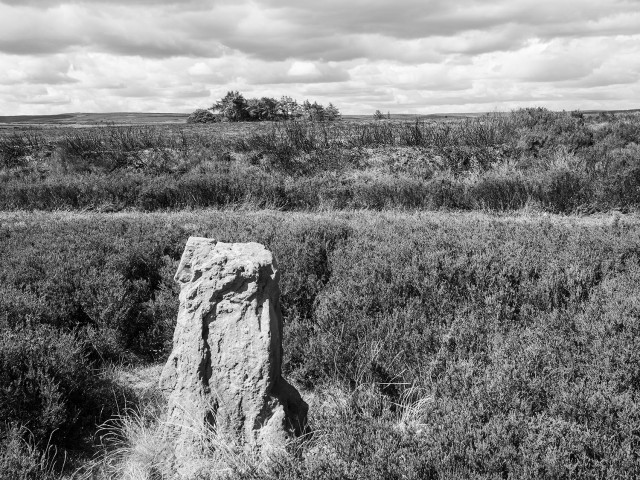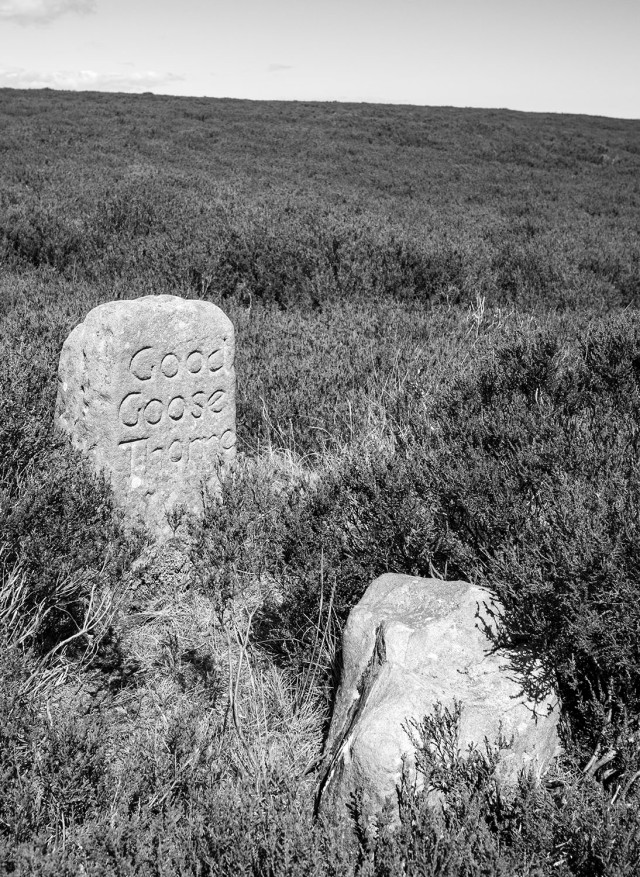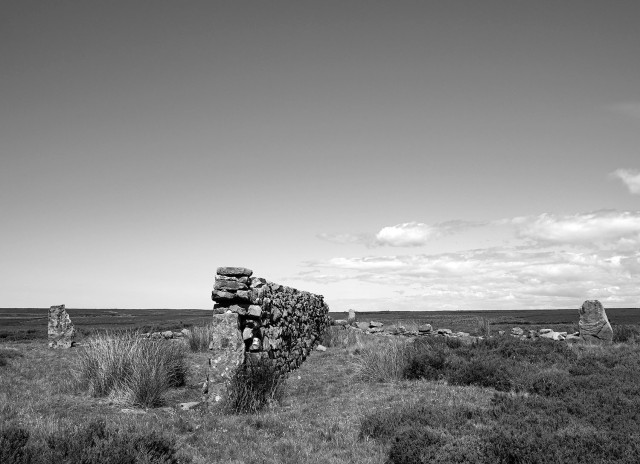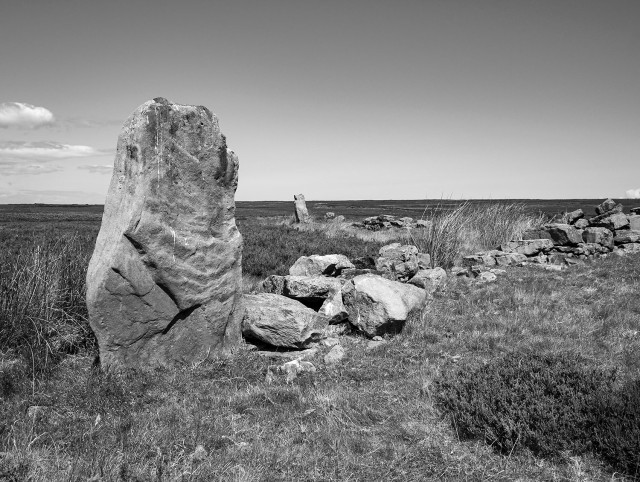Slack – a shallow valley
Swang – a boggy or marshy area
Beck – a small stream
Rigg – a ridge
Bield – a sheep shelter


Easington High Moor, Roxby High Moor and Black Dike Moor form one of my favourite places on the North York Moors. They are an expanse of heather moorland, wetland and grassy moorland. It is difficult to say where one moor finishes and another starts, the boundaries are loosely defined by the Slacks and Riggs.


I follow the old peat road that runs beside the ancient barrow of Sail Howe. Beside the track are a couple of large, unnamed, boundary stones.


Wooden shooting stands march along the edge of the slack. Heather has been machine- cut in a number areas of the moor such as the one above defining the boundary of an area of burning. A days grouse shooting on the moor in August and September will set you back £23,250. This includes a mid morning snack and lunch f or a party of 8 guns. source
 I pass one of the two Good Goose Thorne boundary stones that can be found on the moor. The beautifully mason-lettered stone stands beside it’s ancient predecessor. The path leads me across a section of Black Dike Moor marked as Horse Flesh on the old OS maps. I then drop down to the stepping stones across Black Dike Slack and walk up onto Temple Beeld Hill.
I pass one of the two Good Goose Thorne boundary stones that can be found on the moor. The beautifully mason-lettered stone stands beside it’s ancient predecessor. The path leads me across a section of Black Dike Moor marked as Horse Flesh on the old OS maps. I then drop down to the stepping stones across Black Dike Slack and walk up onto Temple Beeld Hill.






Temple Beeld Hill, is barely a hill. On the higher ground is Temple Beeld itself. The North York Moors has many wonderful sites, what ever its origins, this one is definitely worth a visit.
Frank Elgee’s account and sketch plan of Temple Beeld
.. the most remarkable stones known to me occur on Temple Beald Hill on Black Dyke Moor, north of the village of Lealholm. Here, on a slight elevation between two boggy valleys, a quincunx arrangement of ancient menhirs has been converted into a cross- shaped beald or sheep shelter, shown on the annexed diagram. Originally, the site appears to have been occupied by five stones which are from four to five feet high ; those at C, D and in the centre, being thin and flat, and roughly shaped, whilst the two remaining stones at A and B are more regular and rectangular in form. High stone walls at a later period have been built between the ancient stones ; the wall from A to B is straight, and about thirty-five yards long ; and the wall from C to D decidedly curved and about twenty-two yards in length. This arrangement of the walls gives ample shelter to the moor sheep, and at one time the centre was partly roofed in — the timbers of an old thatch still lie in an irregular manner across the central angles. That the five stones are of pre-historic origin is highly probable, seeing that the central one has distinct cup-like markings at the top of the only side visible. The name Temple, too, is suggestive of some ancient circle of stones, for whatever purpose constructed. It may also be remarked that the four stones are not built into the ends of the walls, but stand off a few inches in distinct hollows in the ground. Temple Beald is the simplest type of stone circle upon the moors, where they are far from common.
Isn’t Quincunx a wonderful word?
In his 1987 book, Standing Stones and Earthworks on the North York Moors, Stanhope White describes how he surveyed Temple Beeld and sent the results to the Royal Observatory to ascertain whether the site had any astronomical alignments, none were found.
I’m sceptical regarding the Prehistoric origins of Temple Beeld as a monument. Three of the large standing may have been erected in prehistory but I suspect they may have been re-used and possibly relocated to create the sheep shelter around a central earth-fast stone. The cup-like marks that Elgee mentions appear to be the result of natural weathering. That said, I hope that one day someone proves me wrong because I love this place.
‘Noble ruins stand only where virgin stone is plentiful’



On my return I call in on the Nan Stone located on the edge of Hardale Slack above the Roxby Peat Holes. The stone has its name carved into it, faded but still legible. As with the Good Goose Thorn, the stone stands beside an earth fast boulder. The older stone has a cross carved into it. I have seen this on other moorland stones, I have also seen these crosses explained as the ‘christianisation’ of an ancient pagan stone. I suspect that the explanation is far simpler and involves the marking of the stone to identify it as a boundary stone. I am planning to write a blog post soon exploring these boundary stones and their meaning.
These three moors are a place that I am constantly revisiting, over the years I have learned much about the North York Moors by walking their tracks and revisiting their sites. A first glance these Moors may appear to be a featureless places, set foot on them and you’ll soon learn that this is not the case.

Sources
The Moorlands of North-Eastern Yorkshire – Frank Elgee. 1912
Standing Stones and Earthworks on the North York Moors – Stanhope White. 1987
